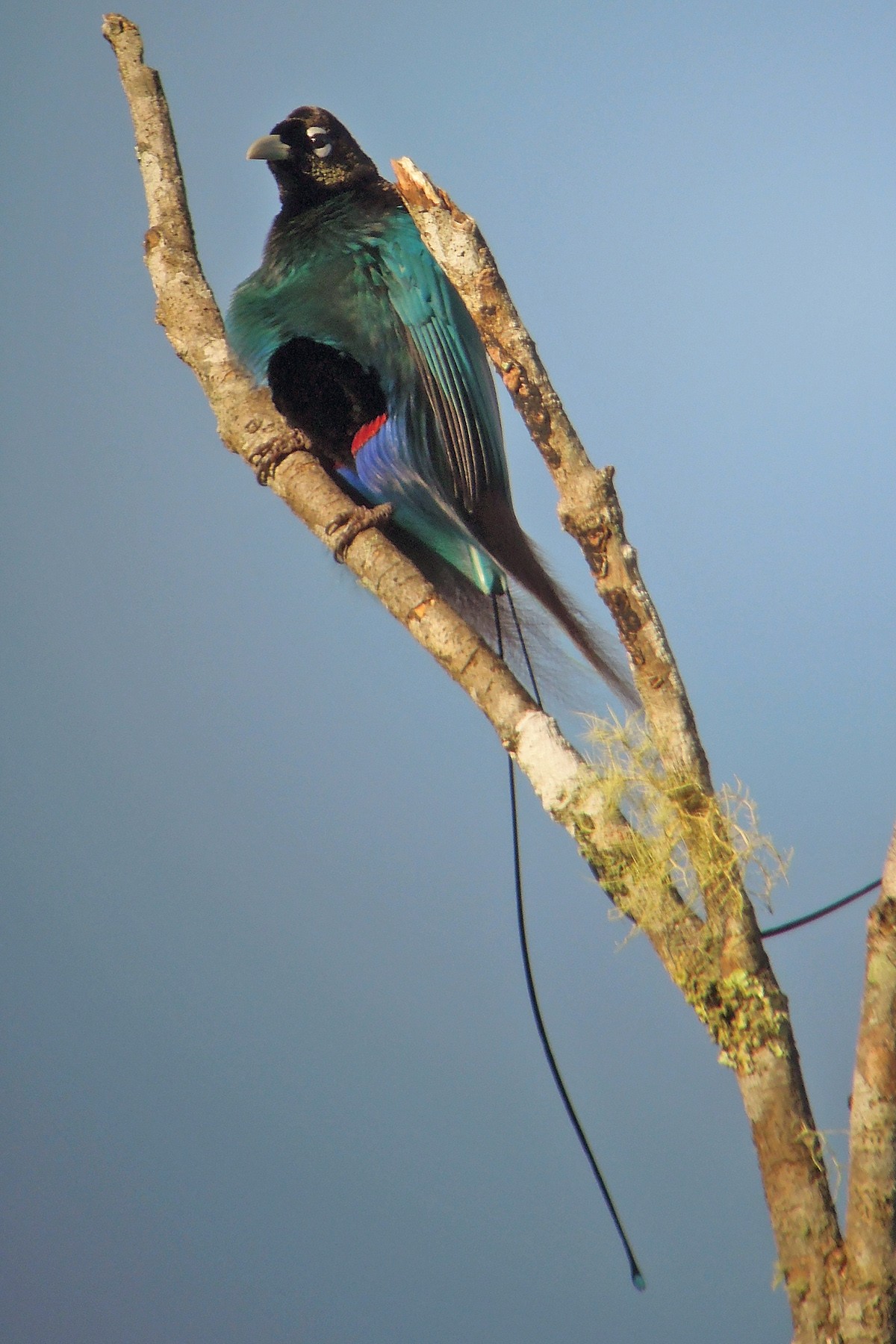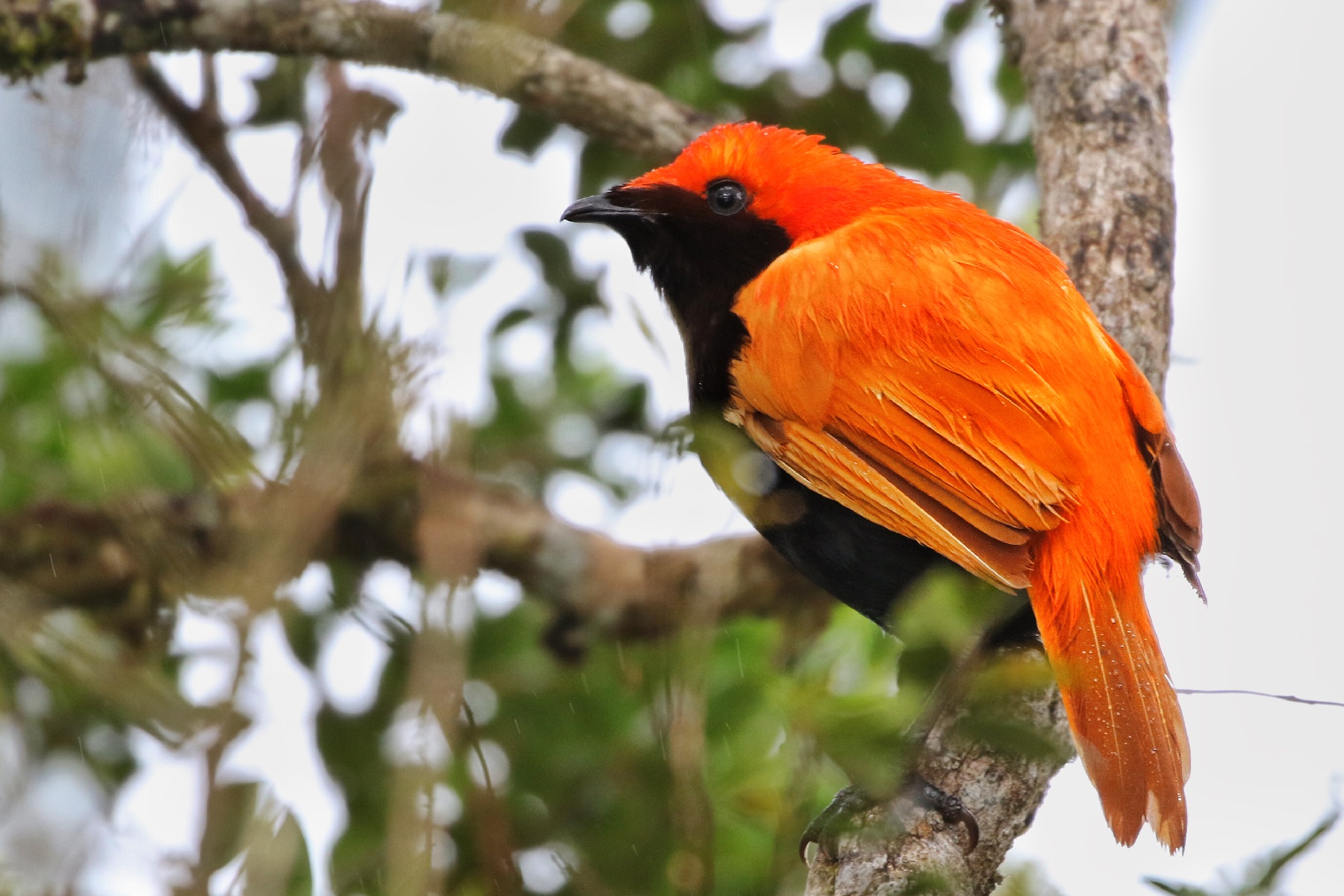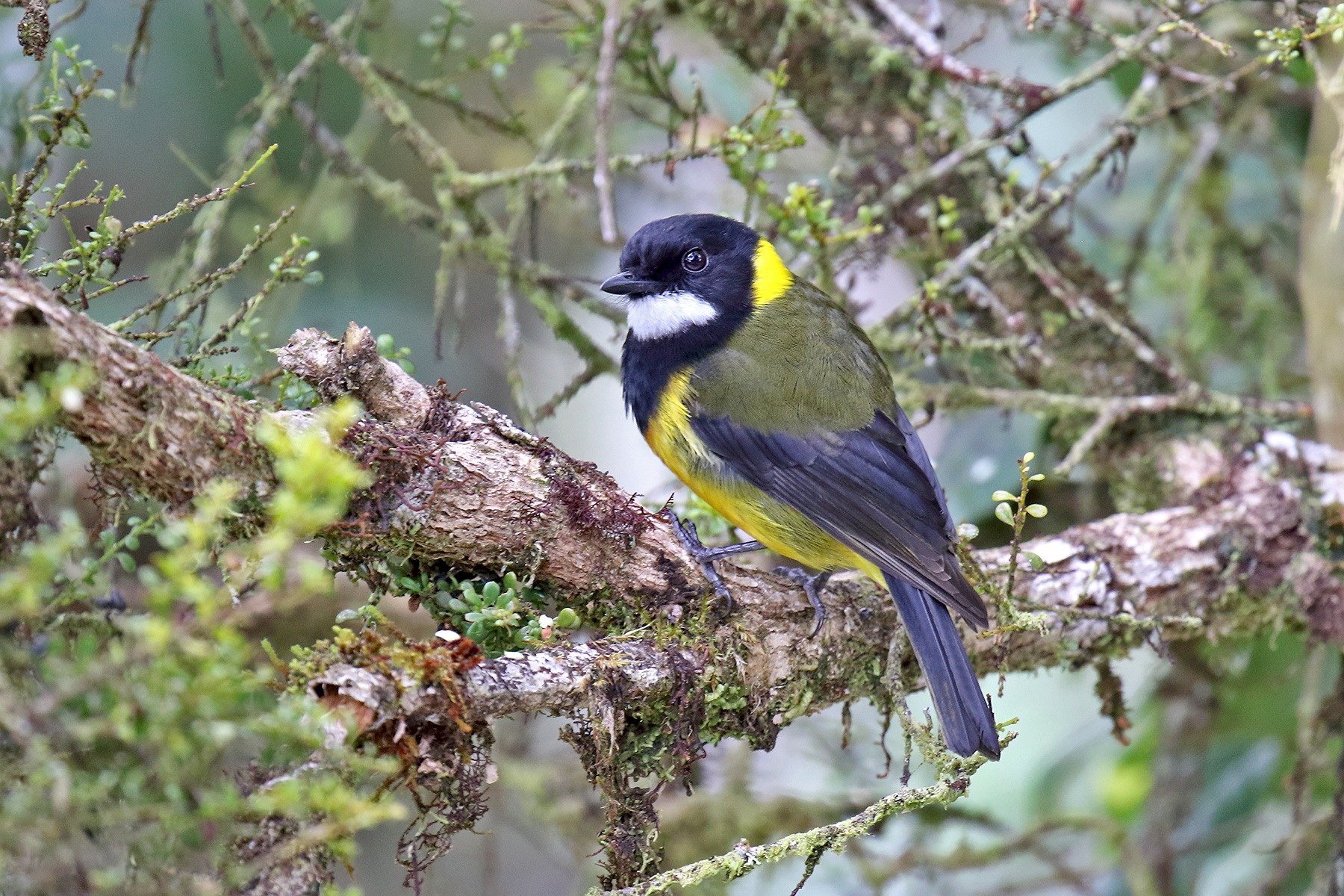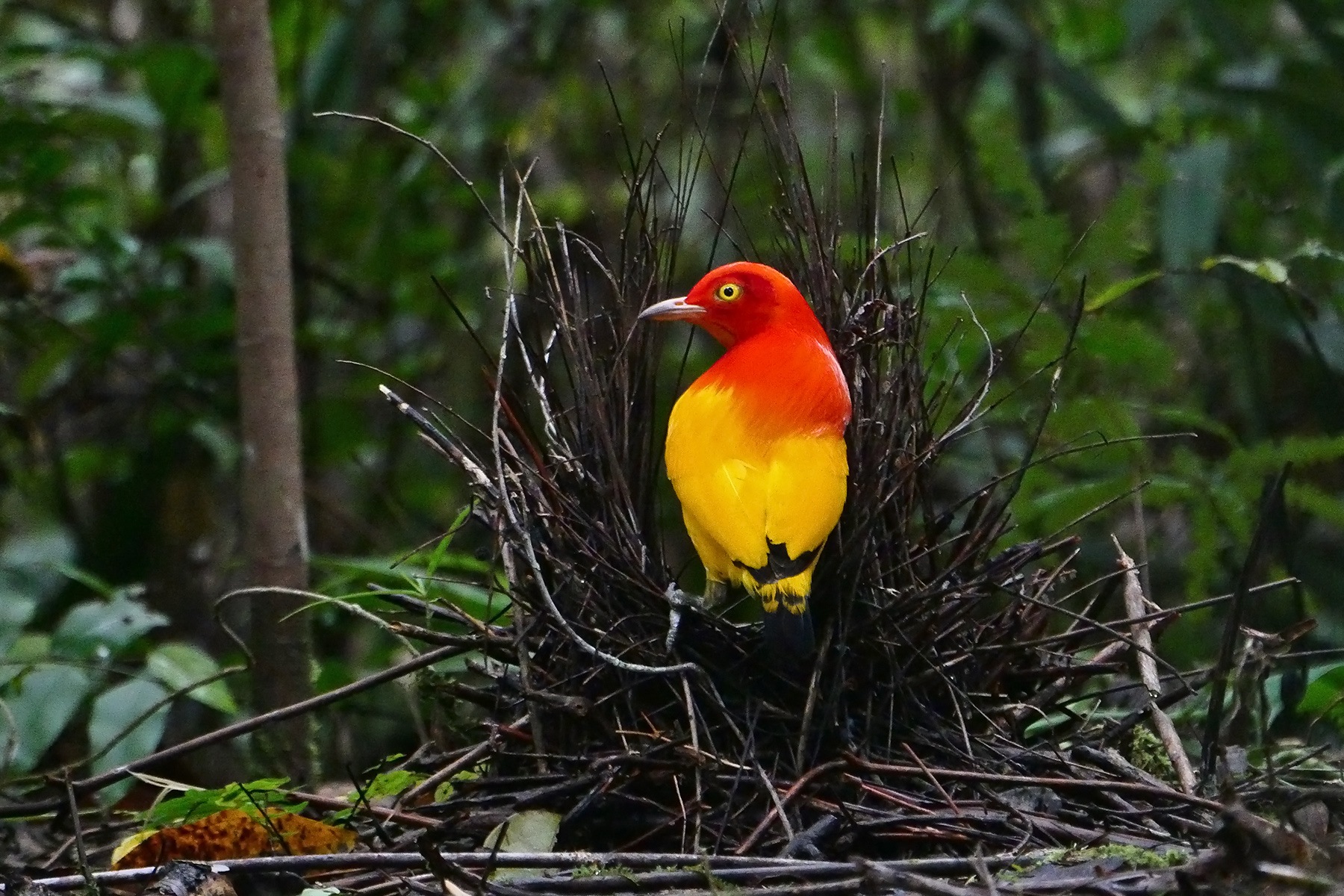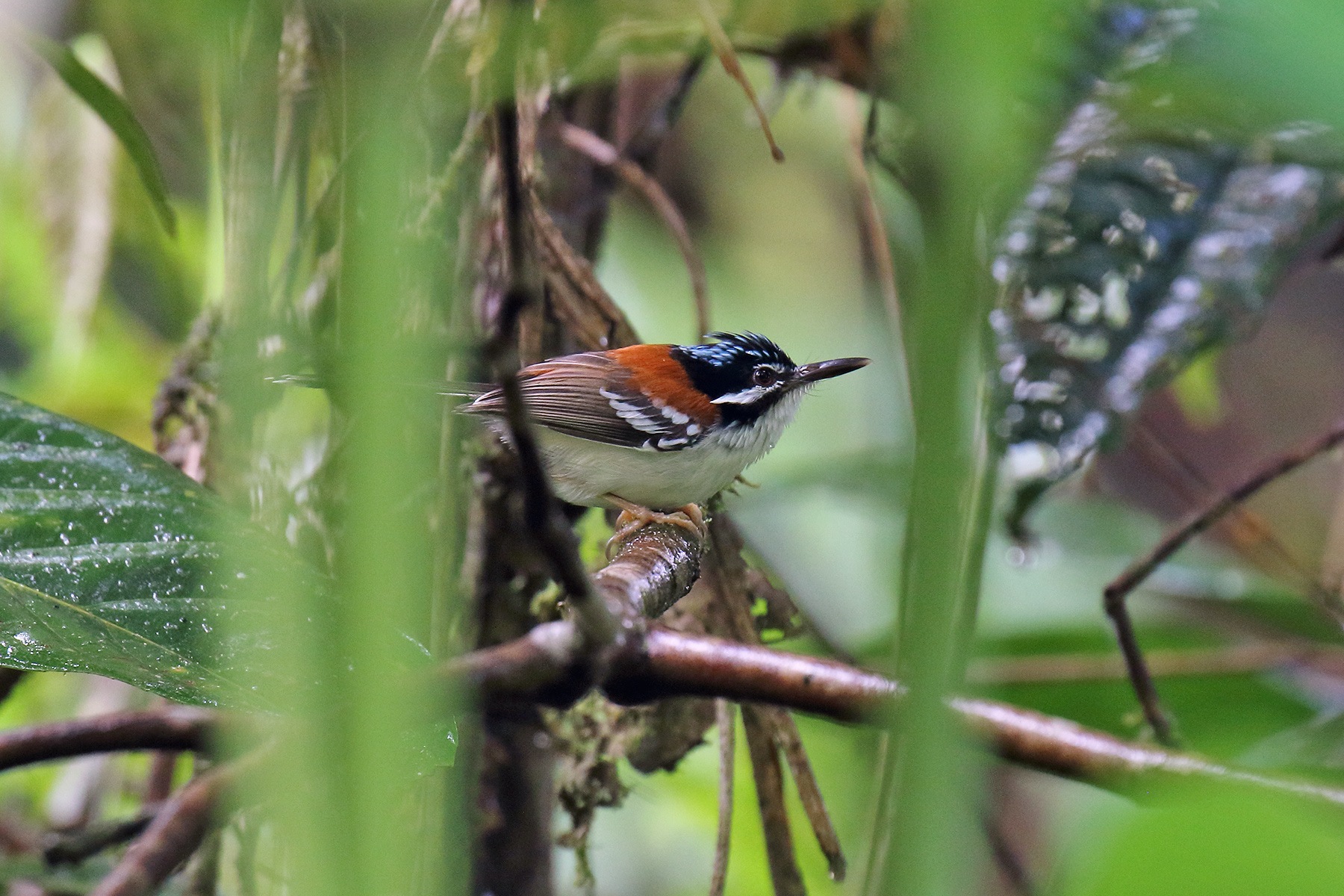CLASSIC PAPUA NEW GUINEA BIRDING TOUR: DETAILED ITINERARY
Papua New Guinea: Day 1 Our Classic Papua New Guinea birding tour begins this morning at Port Moresby.
(Flights into Port Moresby are mostly from Brisbane, Singapore and Manila. If you are arriving the previous day, we can book you into a hotel near the airport on request.)
The eucalypt savanna of the Port Moresby region is an ecological ‘island’ with strong affinities to northern Australia, and beyond lies the tropical rainforest that covers so much of New Guinea, rising steadily from the lowlands up into the Astrolabe range.
We will spend today exploring Varirata National Park, which is situated in the foothills above the city. The park is dominated by dry eucalypt forest and moister evergreen hill forest, and a good system of trails allows easy access to this excellent area. We will spend the night near the park.
Varirata holds many widespread lower-altitude species that we will see elsewhere during the tour, so we shall be concentrating on birds that we are only likely to see here, or which are typically easier at Varirata than elsewhere.
Varirata will give us our first chance to see some of New Guinea’s fabulous birds-of-paradise. The exotic Raggiana Bird-of-paradise, one of the ‘classic’ birds-of-paradise, is quite common here and we may find them displaying. Growling (or Eastern) Riflebirds are very vocal but quite shy and can typically be seen flying between ‘song’ perches.
With persistence, we should get views of the handsome Chestnut-backed Jewel-babbler and with both persistence and luck, we will see one or two of the more difficult skulkers, which include Painted Quailthrush, Piping Bellbird (formerly known as Crested Pitohui and a species with a magical song) and Papuan Scrub Robin.
In the mid-storey, we should come across the unobtrusive Brown-headed Paradise Kingfisher. Indeed, kingfishers are well represented at Varirata, with Yellow-billed, Forest, Azure and Papuan Dwarf Kingfishers all quite likely here. Varirata is also a good place for finding the exquisite Barred Owlet-Nightjar at its day roost.
Other species we may well encounter at Varirata include Amboyna Cuckoo-Dove, Wompoo, Pink-spotted and Superb Fruit Doves, Zoe’s Imperial Pigeon, Large-tailed Nightjar, Glossy Swiftlet, Oriental Dollarbird, Papuan King and Red-cheeked Parrots, the smart Black-capped Lory, Tawny-breasted, White-throated, Elegant and Mimic Honeyeaters, Papuan Black Myzomela, Rusty Mouse-warbler, Pale-billed Scrubwren, Yellow-bellied, Green-backed and Fairy Gerygones, Yellow-breasted Boatbill, Hooded Butcherbird, Barred (or Yellow-eyed) and White-bellied Cuckooshrikes, Black Cicadabird (or Black Cuckooshrike), Varied Triller, Grey Whistler, the poisonous Hooded Pitohui, Brown Oriole, Spangled Drongo, Chestnut-bellied Fantail, Spot-winged Monarch, the splendid Frilled Monarch, Leaden Flycatcher, Lemon-bellied Flyrobin, Black-fronted White-eye, Yellow-faced Myna and Red-capped Flowerpecker.
We should also encounter a few more of the uncommon or hard-to-find birds of the area, which include Brown Goshawk, Pygmy and Gurney’s Eagles, the retiring Pheasant Pigeon (likely to be heard but very hard to see), Spectacled Longbill, White-bellied Whistler, Variable Shrikethrush, Black-faced Monarch, White-faced Robin, Olive Flyrobin and Ochre-breasted (or White-eared) Catbird, as well as the intriguing Goldenface (formerly known as Dwarf Whistler, but now reclassified as an Australasian warbler) and Drongo Fantail (formerly known as Pygmy or Mountain Drongo, but now reclassified as a fantail and discovered to be related to the silktails of Fiji).
Papua New Guinea: Day2 After a final morning at Varirata we will return to the Port Moresby airport area to spend the night.
This afternoon we shall visit some small ponds on the edge of the city that hold such species as Australasian Grebe, Little Black and Little Pied Cormorants, Eastern Cattle, Great, Intermediate and Little Egrets, the attractive Pied Heron, Nankeen (or Rufous) Night Heron, Wandering and Plumed Whistling Ducks, Raja (or White-headed) Shelduck, Pacific Black Duck, Dusky Moorhen, Australasian Swamphen, the pretty Comb-crested Jacana and Masked Lapwing. If we are fortunate we will also see one or two of the more uncommon visitors, which include the rare and crepuscular Spotted Whistling Duck, Grey Teal, the pretty Green Pygmy Goose, Australian White Ibis and Australasian Darter.
The adjacent eucalypt savanna, ‘kunai’ grassland and gardens hold a broad range of species including Black, Whistling and Brahminy Kites, Peaceful and Bar-shouldered Doves, Orange-fronted Fruit Dove, Torresian Imperial Pigeon, Pheasant Coucal, the impressive and vociferous Blue-winged Kookaburra, Sacred Kingfisher, Rainbow Bee-eater, Australian Hobby (uncommon), Coconut Lorikeet, New Guinea Friarbird, Yellow-tinted and Rufous-banded Honeyeaters, White-breasted Woodswallow, Black-backed Butcherbird, Black-faced Cuckooshrike, Grey Shrikethrush, the entertaining Willie Wagtail, Australasian Figbird, Torresian Crow, Singing Starling, Pacific Swallow and Grey-headed Mannikin.
We also have a good chance of finding the huge, reptilian-looking Papuan Frogmouth at its daytime roost. Fawn-breasted Bowerbirds are quite common in the area and if we find one of their remarkably complex bowers we may be rewarded by hearing the bird’s strange repertoire of hisses, gurgles, pops and burps.
Papua New Guinea: Day 3 This morning we will fly far to the west, to the town of Kiunga, and then drive up the winding road through the foothill forest to Tabubil, situated at the base of the Star Mountains, for a four nights stay.
As our plane carries us across the southern lowlands we will begin to appreciate the immensity of the forest that even today covers more than 90% of New Guinea. Once the settled areas around Port Moresby are left behind hardly anything breaks the pattern of the forest, other than the meandering rivers.
On our way to Tabubil, we will begin our exploration of this exciting area, so we are sure to see a good number of new birds today. In particular, we shall stop en route by the Ok Tedi River to look for the interesting resident papuanus form of the Little Ringed Plover and also at a lookout from where the spectacular Pesquet’s (or Vulturine) Parrot can regularly be seen.
Papua New Guinea: Days 4-6 The Ok Tedi mine above Tabubil is one of the largest copper mines in the world and the town and its road network has primarily been created as a result of the mine’s development, thus allowing us to explore the southern foothills of the remote Star Mountains. Many of the birds found here are of widespread distribution throughout the hill forests of New Guinea, but others are much more localized and there are a series of superb specialities to be found. Furthermore, with the completion of the new road to the remote settlement of Telefomin, an even wider range of habitats can now be covered while we are based in comfort in Tabubil.
The hillsides are very steep and gaining access to good forest is an issue in the Tabubil area, particularly as accessible areas are often quickly cleared for ‘gardens’. Tabubil is also the wettest area that we shall visit and so we shall be hoping for good weather, as there are plenty of special birds to look for.
One of the star specialities here is the dazzling and rather illusory-looking Queen Carola’s Parotia, and although adult males can be hard to find, we should at least see females or young males in a fruiting tree. Shovel-billed Kookaburras (or Shovel-billed Kingfishers) also occur in the area and we shall listen out for the calls of this crepuscular species, although it will take persistence and a bit of luck to see one.
Two of New Guinea’s least-known birds, Greater Melampitta and the unassuming Obscure Berrypecker, are also to be found in the Tabubil region, but both require a bit of luck. There is even the possibility of encountering the very rare Sooty Shrikethrush. Easier specialities include White-rumped Robin, Spotted Berrypecker, Yellow-breasted Satinbird and Magnificent Bird-of-paradise.
We will also pay a visit to one of the many rivers rushing down from the surrounding mountains that has proved to be a reliable site for Salvadori’s Teal, Torrent Flyrobin (or Torrent Flycatcher) and sometimes Torrent-lark.
Other species we may well encounter at Tabubil, but which we are unlikely to see elsewhere during the tour, include Chestnut-breasted Cuckoo, White-eared Bronze Cuckoo, Spotted Honeyeater and Southern Variable Pitohui.
There will be plenty of more widespread species that will be new for the trip and these may well include Papuan Mountain Pigeon, Long-tailed Honey Buzzard, Papuan Boobook, Uniform Swiftlet, Moustached Treeswift, Orange-breasted Fig Parrot, Long-billed, Mountain and Scrub Honeyeaters, Mountain Peltops, Stout-billed and Boyer’s Cuckooshrikes, Great Woodswallow, Capped (or Western Mountain) White-eye and Crinkle-collared Manucode (an atypical bird-of-paradise).
We should also encounter some of the more uncommon birds of the area, which include Doria’s Goshawk, Pale-vented (or Rufous-tailed) Bush-hen, Ornate Fruit Dove, Metallic Pigeon, Dwarf Koel, Brown Falcon, Striated Lorikeet, Red-breasted Pygmy Parrot, Blue-collared Parrot, Orange-fronted Hanging Parrot, Wallace’s Fairywren, Red Myzomela, Pygmy Longbill, Sooty Thicket Fantail and Magnificent Riflebird.
Papua New Guinea: Day 7 After a final morning in the Tabubil area we shall descend to Kiunga for an overnight stay. The sparsely populated lowlands of southwestern Papua New Guinea around Kiunga are still one of the least disturbed areas in the country.
Papua New Guinea: Days 8-9 We shall set off early in a small open-top fibreglass boat in order to explore the Fly and Elevala Rivers and their tributaries, spending two nights camping at ‘Ekame Lodge’ (otherwise known as ‘Kwatu Lodge’ but now little more than a basic campsite – see accommodation section) set deep in the depths of the swamp forest jungle surrounding the Elevala River.
We shall be aiming to reach a display post of the amazing Twelve-wired Bird-of-paradise in good time to see the male running up and down the pole in order to win his females. This strange behaviour lasts for a very short period just after dawn each morning and so we will rely on our local guide’s knowledge to get us there in time to witness the display. After a hopefully successful encounter, we shall be able to sit back, relax and watch the spectacle of the forest awakening.
As we cruise up the murky and muddy river, hundreds of birds will be flexing their wings and voices and preparing for the new day. We can expect to see large numbers of Collared Imperial Pigeons, mixed with smaller numbers of Pinon Imperial Pigeons, as they erupt from the treetops as we pass by. Large flocks of Blyth’s Hornbills flap lazily from tree to tree and strange, spiky-crested Palm Cockatoos and Glossy-mantled Manucodes are a feature of the journey. Parrots are everywhere, with Eclectus Parrots and Sulphur-crested Cockatoos dominating the show. Shining Flycatchers skim low over the water and occasionally an enormous Great-billed Heron may be flushed from the banks. In particular, we shall be looking out for the huge Sclater’s Crowned Pigeon, one of the largest and most mysterious pigeons in the world. It may take us some time to locate one, but we have a good chance of success and the sight of this incredible bird is one that will surely last a lifetime.
We shall also be able to land at various locations where small trails have been made for us into the otherwise impenetrable forest. Here we shall be on the lookout for the gorgeous but diminutive King Bird-of-paradise and we shall hope to find one of the staked-out males that are amazingly faithful to their display trees. Greater Bird-of-paradise and Trumpet Manucode are also found regularly in the area.
Rarities such as White-bellied Pitohui and the pretty Little Paradise Kingfisher occur in these swampy forests and among the bird parties we shall hope to find difficult species such as Hooded Monarch and Papuan Babbler. Attractive Black-sided Robins sing loudly from the interior and Common Paradise Kingfisher, the stunning Rufous-bellied Kookaburra and the crepuscular Hook-billed Kingfisher are also major attractions here. There will also be a good opportunity to see the intensely-coloured Flame Bowerbird.
Southern Cassowary occurs in the area, but we would need to be very fortunate to see this shy creature. The raucous calls of Black-billed (or Yellow-legged) Brush-turkeys can be heard regularly, but we will need a lot of luck if we are to see this shy denizen of the area, perhaps near one of its large nest mounds. There is also a slim but real chance of seeing the peculiar and rarely observed New Guinea Flightless Rail.
Other birds that we may well see during our visit to Kiunga and the Elevala include Striated Heron, Pacific Baza, Variable and Grey-headed Goshawks, White-bellied Sea-Eagle, Great Cuckoo-Dove, Stephan’s Emerald Dove, Beautiful, Orange-bellied and Dwarf Fruit Doves, Purple-tailed Imperial Pigeon, Pacific Koel, White-crowned, Brush and Channel-billed Cuckoos, Papuan Spine-tailed Swift, Yellow-capped Pygmy Parrot, Red-flanked Lorikeet, Double-eyed Fig Parrot, Yellowish-streaked (or Greater Streaked) and Dusky Lories, the lovely Hooded and Papuan Pittas, Plain, Green-backed, Streak-headed and Obscure Honeyeaters, Large-billed Gerygone, Black Berrypecker, Yellow-bellied Longbill, Lowland Peltops, Black Butcherbird, Grey-headed and Golden Cuckooshrikes, Arafura Shrikethrush, the shy Rusty Pitohui, White-bellied Thicket Fantail, Rufous-backed Fantail, Grey Crow, Golden Myna, Metallic and Yellow-eyed Starlings, and Black Sunbird
This is a good area for Blue Jewel-babbler and with persistence, we should have a good chance of enticing one into view. We should also find a few of the more uncommon species, which include Ivory-billed (or Greater Black) and Black-billed (or Lesser Black) Coucals, Little Bronze Cuckoo, Large Fig Parrot and Ruby-throated (or Red-throated) Myzomela.
Nightbirding is difficult and sometimes unrewarding here, but with persistence and good fortune, we have the chance to encounter such species as Marbled Frogmouth, Papuan Nightjar, Wallace’s Owlet-Nightjar or even the rare and little-known Starry (or Spangled) Owlet-Nightjar.
Papua New Guinea: Day 10 After some final birding in the Elevala River area, we shall return to Kiunga for a good shower and a comfortable bed for an overnight stay.
During our time at Kiunga, we will visit a mixed display ground of both Greater and Raggiana Birds-of-paradise. Although the former is much the more numerous species here, males of both species can often be seen competing for the females and hybrids do occur. If there is good display activity, this will be a highlight of the tour.
We shall also listen out for the distinctive whistles of the localized Long-billed Cuckoo and hunt out the gorgeous Emperor Fairywren.
If we are lucky we will find one or more of the less frequently recorded species of the Kiunga area, which include New Guinea Bronzewing, Buff-breasted Paradise Kingfisher, Black-eared Catbird and Meyer’s Friarbird.
Papua New Guinea: Day 11 We may have time for some final birding at Kiunga before we take a flight to Mount Hagen, the capital of the Papua New Guinea highlands. Our flight takes us over unbroken foothill forest, mountain ridges and eventually the rich cultivated valleys of the New Guinea highlands.
Until the 1930s, the highlands of New Guinea were thought to be uninhabited, and so the discovery by some intrepid European gold miners of a large human population numbering over a million people living in stone-age conditions in total isolation from the rest of the world was one of the great discoveries of the 20th century.
We will be spending a total of seven nights in the Mount Hagen region. The first five nights will be spent at the famous Kumul Lodge and for the final two nights we will be staying at the luxurious Rondon Ridge Lodge, which has some specialities that are absent or scarce around Kumul. Upon arrival at Mount Hagen airport, and after climbing out of the fertile valley around the town and into the subalpine forest, we will continue to Kumul Lodge in Enga province. Depending on the flight schedule, we may arrive in time for some initial exploration.
Papua New Guinea: Days 12-17 Kumul Lodge is situated on a high ridge covered in pristine montane forest and the bungalows, which each have their own veranda with a view out over the surrounding valleys, are surrounded by 27 hectares (67 acres) of private grounds.
A feeding station has been set up outside the dining room and, because of the no-hunting policy adopted by this community-run project, the birds have become incredibly tame. A ‘sit and wait’ policy can be productive here. Belford’s Melidectes and Common Smoky Honeyeaters are numerous, and these are joined by huge Brown Sicklebills (their deafening rattles sound just like a machine gun), graceful Ribbon-tailed Astrapias, Brehm’s Tiger Parrots and even Archbold’s Bowerbirds. At Kumul these wonderful birds, which are so shy elsewhere, can be watched from only a few metres away and so the photographic opportunities are often superb.
Island Thrushes hop around the lawns, Red-collared Myzomelas feed from the flowers and Friendly Fantails, White-winged Robins and Rufous-naped Whistlers (or Rufous-naped Bellbirds) are all common garden birds, while Grey-streaked Honeyeaters are often present.
A star attraction of Kumul is the ghost-like Lesser Melampitta, one of only two members of its family, which we can expect to see as well as hear. Additional major attractions are the gorgeous but poisonous Blue-capped Ifrit (now a monotypic bird family) and the strange Wattled Ploughbill (likewise now treated as a monotypic family).
Another very special bird in the Kumul area is the rare Mottled Berryhunter (the former Mottled Whistler, now treated as a monotypic family). We will definitely be making an effort to find this key species and we have good chances of an encounter while based at Kumul and again at Rondon Ridge.
Other specialities of Kumul include Crested Satinbird (there is often a male that frequents the lodge), Rufescent Imperial Pigeon, Mountain (or Elfin) Myzomela and Ornate Melidectes
The nightbirds that frequent the vicinity of Kumul Lodge are another prime reason for our visit. As the day draws to a close we have a good chance of encountering the pair of New Guinea Woodcocks that shuffle out from their daytime hiding places to feed around the camp. From dusk onwards we will look in particular for Greater Sooty Owl, both Feline and Mountain Owlet-Nightjars and Archbold’s (or Mountain) Nightjar.
Kumul and its surrounding area is a wonderful place for birds-of-paradise and, as well as those species already mentioned, we should encounter Loria’s Satinbird, the amazing King of Saxony Birds-of-paradise with its fantastically long head-plumes that look like strange antennae and the beautiful Princess Stephanie’s Astrapia. We will also visit a patch of remnant forest in order to see Lesser Bird-of-paradise and visit a hillside where Blue Bird-of-paradise can often be seen and where Greater Lophorina can be watched fanning its strange collar. In addition, we will check out grassland areas that are favoured by Yellow-breasted Bowerbirds.
Rondon Ridge, a beautifully constructed and indeed luxurious lodge, has some additional species that are much more easily seen here than around Kumul. Notable among these is the impressive Black Sicklebill, which shows off its remarkable display along the forest edge soon after dawn. Others include Macgregor’s Bowerbird, Grey Thornbill, Lesser Ground Robin, Sclater’s Whistler, Black Pitohui, Mid-mountain Berrypecker, the rather uncommon Papuan Sittella and Yellowish-streaked Honeyeater.
Amongst the many other birds we may well find while based at either Kumul or Rondon, as we search the mossy forest, gullies with epiphyte-encrusted trees and rocks, and grasslands and mixed agricultural habitats, are Papuan Harrier, Black-mantled Goshawk, Bar-tailed (or Black-billed) Cuckoo-Dove, White-bibbed (or Mountain) Fruit Dove, Fan-tailed Cuckoo, Mountain Swiftlet, Brown Falcon, Goldie’s, Plum-faced, Papuan, Yellow-billed and Orange-billed Lorikeets, White-shouldered Fairywren, Rufous-backed, Black-throated and Marbled Honeyeaters, Yellow-browed Melidectes, Mountain Mouse-warbler, Large, Buff-faced and Papuan Scrubwrens, Brown-breasted Gerygone, Fan-tailed, Tit and Crested Berrypeckers, Black-breasted Boatbill, Long-tailed Shrike, Black-bellied Cuckooshrike, Sepik-Ramu Shrikethrush, Brown-backed, Regent and Black-headed Whistlers, Dimorphic and Black Fantails, Black Monarch, Black-throated, Ashy and Slaty (or Blue-grey) Robins, the cute Canary Flyrobin, Pied Bushchat, Island Leaf Warbler, Papuan Grassbird, Mountain Firetail, Blue-faced Parrotfinch, Hooded Mannikin and Australian Pipit.
We will also come across a selection of the more difficult species of the area, which include Meyer’s Goshawk, Brown Quail, Chestnut and Forbes’s Forest Rails, Buff-banded Rail, Rufous-throated Bronze Cuckoo, Mountain Kingfisher, Oriental Hobby, Painted, Modest and Madarasz’s Tiger Parrots, Red-breasted Pygmy Parrot, Blue-collared Parrot, Black-shouldered (or Papuan) Cicadabird, Hooded Cuckooshrike, Spotted Jewel-babbler, Black Sitella, the lovely Garnet Robin, Papuan Parrotfinch and two more birds of paradise – the strange Short-tailed Paradigalla and Lawes’s Parotia. The magnificent Papuan (or New Guinea) Eagle is occasionally encountered in the area, although this very secretive bird is generally easier to hear than to see.
Papua New Guinea: Day 18 After some final birding in the Mount Hagen region we will take a flight to Port Moresby for an overnight stay.
Papua New Guinea: Day 19 The main section of our Classic Papua New Guinea birding tour ends this morning at Port Moresby.
NEW BRITAIN EXTENSION
Papua New Guinea (New Britain): Day 1 The extension begins with a morning flight from Port Moresby in ‘mainland’ Papua New Guinea to the small town of Hoskins on the island of New Britain for a four nights stay at nearby Kimbe Bay. Later we will begin our exploration of this interesting island with its many special birds.
Papua New Guinea (New Britain): Days 2-4 New Britain, the largest island of the Bismarck Archipelago, has the richest avifauna of any island in the Southwest Pacific (excluding New Guinea itself of course). Many of the species that we will see are either endemic to New Britain alone or to the Bismarck archipelago as a whole (and sometimes the Solomon Islands also). We shall explore the patches of rainforest that are still to be found amongst the vast oil palm plantations. The huge trees harbour many spectacular pigeons and parrots, and several species may be seen feeding in the same fruiting trees.
Imperial pigeons are very well represented; Yellowish (or Yellowish-tinted) restrict themselves to the coastline, whilst the numerous Red-knobbed is more catholic, occurring throughout the forest, and Island is, as the name suggests, most common on offshore islands. Two foothill species range down to the adjacent lowland forest; the scarce Black (or Bismarck) is a canopy-frequenting species that we rarely encounter, while the secretive Finsch’s keeps inside the canopy and is difficult to locate except by its distinctive call.
The fruit doves are represented by Knob-billed, closely related to the Orange-bellied of the mainland, whilst the rarely-seen Yellow-bibbed is a largely ‘small island’ form related to White-bibbed. Mackinlay’s Cuckoo-Dove favours edges, while Pied Cuckoo-Dove is a fairly scarce forest interior inhabitant and the diminutive terrestrial White-breasted Ground Dove also occurs amidst the gloom but is often very difficult to find. Noisy Blue-eyed Cockatoos are one of the most conspicuous parrots and Purple-bellied (or Eastern Black-capped) Lories are also numerous. Strikingly large Great Flying Foxes can be seen flapping and gliding lazily overhead.
Other species we may well encounter include in this interesting part of Papua New Guinea include Melanesian Megapode (or Melanesian Scrubfowl), Black Bittern, Variable Goshawk (commoner here than anywhere we visit on the mainland), Oriental Hobby, Buff-banded Rail, White-browed Crake, Violaceous and White-necked (or Pied) Coucals, New Britain Boobook, White-rumped Swiftlet, Black-capped (or Black-headed) Paradise Kingfisher, Melanesian and Common Kingfishers, New Britain Dwarf Kingfisher, the tiny Buff-faced Pygmy Parrot, Song Parrot, Ashy and Black-bellied Myzomelas, New Britain Friarbird, Bismarck Whistler, Northern Fantail, Black-tailed (or Bismarck Pied) Monarch, Velvet (or Dull) Flycatcher, Bismarck (or Island) Crow, Australian Reed Warbler, Golden-headed Cisticola, Red-banded Flowerpecker, Olive-backed (or Yellow-bellied) Sunbird, Buff-bellied Mannikin and Long-tailed Myna.
We should also find a few of the more uncommon birds of the area, which include King Quail, Black Honey Buzzard, Pink-legged (or New Britain) Rail, Bronze Ground Dove, Shining Bronze Cuckoo, Bismarck Hanging Parrot, White-mantled (or New Britain) Kingfisher, Bismarck Pitta, Common Cicadabird and Bismarck White-eye. In recent times we have seen the rare, beautiful and little-known Golden Masked Owl on a number of occasions in the Walindi area, so we will hope this good fortune continues.
We will also travel by boat out to one of the small offshore islands to look for the spectacular, small-island-specialist Nicobar Pigeon, Beach Kingfisher, Mangrove Golden Whistler and two small-island ‘tramp’ species, Island Monarch and the lovely Sclater’s Myzomela.
White-bellied Sea Eagles loaf around the islands and we should also find Lesser (and perhaps Great) Frigatebirds, Brown Booby, Pacific Reef Heron, Osprey, Greater Crested, Black-naped and perhaps Common Terns, and Black Noddy. (Visits in August/September may also turn up migrant shorebirds such as Pacific Golden Plover, Eurasian Whimbrel, Grey-tailed Tattler and Ruddy Turnstone.) Even the little-known Heinroth’s Shearwater and Beck’s Petrel have been seen on rare occasions in the bay.
Papua New Guinea (New Britain): Day 5 Today we will take a morning flight back to Port Moresby, where the tour ends.










